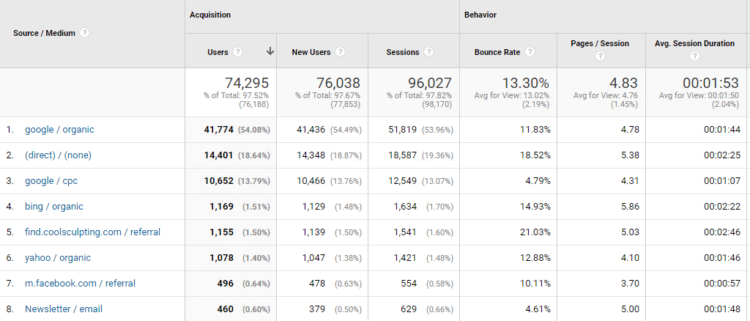**Original article published Dec 2019. Updated and re-published November 2020
As a marketing agency, we use a ton of technology to get work done. This inevitably leads to software “bloat,” meaning we’re overpaying for some technology that we’re not fully utilizing or we’re paying for two solutions when one will suffice.
This same problem exists with aesthetic practices, whether you’re a med spa, dermatologist, or plastic surgeon. My advice to you is to set time aside with your practice manager to audit all your software at least twice a year, if not every quarter, to ensure you’re utilizing every tool you’re paying for and that you’re not overpaying for tools you don’t need.
Here’s a breakdown of the top 12 tools every aesthetic practice needs to be utilizing:
1) EMR: Electronic Health Records are a digital version of your paper charts. This is step 1 in “going digital.”
2) Appointment Scheduling: Your practice needs a digital calendar to keep track of appointments and rescheduling patients. This software should be able to automatically call, text and/or email patients upon scheduling and within 24 hours of the appointment.
*2020 Update: Since the original article was published a lot has happened in the world! Covid-19 has hit the U.S. and other countries hard and changed the way we communicate and handle appointments. Texting is critical and dialing in your waiting room process is critical. If you’re having patients wait in the parking lot til you can see them this needs to be clearly articulated ahead of time, with expectations set on how long they’ll need to wait, and everything communicated via text, at a minimum.
Virtual consultations are no critical for many practices so make sure you have the right software dialed into your practice’s processes.
3) Lead Scoring/CRM: Before a patient spends any money with you they are a prospect. Since leads are the lifeblood of any aesthetic practice that is focused on growth, you need a way to keep track of your leads and “score” them, meaning note the stage of the sales cycle they’ve gotten to, last time you corresponded, email attempts, phone calls attempts, and much more.
Even better if your software can track the source of where the lead came from, such as Google organic, Instagram referral, and even offline sources, such as a patient referral.

*2020 Update: We strongly recommend an “intelligent CRM,” one that can help automate the initial followup with leads generated to help increase the percentage who you actually get ahold of. You should be automating texts, emails, and potentially even ghost voice mails, tailored as much as possible to the type of lead that came in (what they’re interested in).
Keep in mind, however, that this automation does NOT take the place of a savvy salesperson helping to convert these leads into consultations. You need BOTH to really be successful.
4) Email Marketing: This one is self-explanatory, and it can be used to interact with both prospects and patients. In fact, list segmentation is the key to more effective email marketing. This can be done with different email lists or tags to delineate patient interests and it allows you to better serve, both prospects and patients, content they’re interested in, increasing the odds of an open, click, or conversion.
Check out this article that breaks down TRBO Mail vs. Mail Chimp vs. Constant Contact.
5) Review/Reputation Management: You need a proactive approach to review generation. A software can help you connect with patients who have recently visited your practice to ask them for a review. Flexibility and automation are key here.

You want the software to be flexible in how it can be utilized. For example, the ability to ask a patient for a review on-the-spot while they’re in the practice or send out an email or text to a group are both valuable.
If you can automate this workflow to minimize the need for your staff to use the software then you’ve got a winning formula. Magic Rating is one such software. Check out this case study of how one practice increased their star rating from 2.9 to 4.1 in less than 6 months!
*2020 Update: If you can sync either your appointment scheduling software (#3) or CRM (#4) with your review generation software (#5) then you can capture a review at the perfect time, when the patient is happiest. Ideally, this is done right at or after the ‘checkout process’ when a patient is leaving after treatment or a post-op follow-up after surgery. A text message is your best bet here. If you can automate this process, even better.
6) Call Tracking: Every practice needs call tracking. Your digital traffic is coming from many sources. You’ll likely see these 2 key sources/mediums at the top of your traffic reports: google/organic and Direct.
However, if you’re running ads then you’ll likely see many more sources driving traffic, including: instagram/cpc, google/cpc, or yelp/referral traffic. That doesn’t even include newsletter/email, bing/cpc, facebook/referral, or bing/organic.

As you can see, there are a lot of ways to drive traffic, and if you’re putting any money at all into digital advertising then you need a way to tie a name to a source, so you can see if that lead converted and then calculate ROI. This means instead of simply seeing that you generated 10 leads from this ad campaign, seeing who exactly those 10 leads are is crucial.
You should be doing this via hidden fields with web leads, but for phone call leads you need call tracking set up to accomplish this.
*2020 Update: A quality call tracking software will allow you to drill down to even the keyword searched that lead to the call, for paid traffic. Additionally, you’ll want the baulity to track calls for quality assuarnce and evaluating the effectiveness of your sales team.
To the note about hidden fields in web lead forms…with the end of cookies coming, this is going to be less reliable. We recommend that, at the very leads, you set up unqiue landing pages with unique forms on them that cannot be accessed from anywhere but a specific source/medium, such as Google Ads. Then you know with 99.9% certainty that lead came from Google Ads, for example. If you can then sync these forms with automaion sequences then you’re really upping your digital marketing game.
7) Texting: The ability to text both prospects and patients in 2020 is a must. This feature may actually be bundled into another software, such as appointment scheduling. Just make sure that, like email marketing, you can clearly distinguish prospects from patients and have unique workflows for connecting with both.
8) Website Health Monitoring: Your practice should be actively monitoring the website speed, broken links, 404 errors, mobile compatibility, crawl errors, and more. These errors can not only hurt your SEO but also increase bounce rates and decrease conversions. Fortunately, there are many different tools you can do to manage this task, including some free tools…
- Free tool: Google Search Console
- Additional (paid) tools: SEMRush site audit, Ahrefs

*2020 Update: Another tool to add to the mix here is Pingdom, or another uptime checking software, as no hosting provider will alert you immediately if your website goes down. This is critical as you can e unaware for hours or even days that your site is down.
9) Search Ranking Tracking: If your goal is to increase the organic visibility of your website on search engines then you need to first have a plan for improving your rankings, and second, have a way to keep track of your rankings. Fortunately, there are many different tools you can do to manage this task, including some free tools…
- Free tool: manually track in spreadsheet using
- Additional (paid) tools: SEMRush position tracking, Ahrefs

10) Eventbrite: this is your go-to tool for helping gather RSVPs for your next event. You can sync events to Outlook and Google calendars, sync with Facebook events, send reminders, and much more. Best of all, there’s a free version!
11) Google Analytics: this isn’t the only tool available for tracking website traffic, activity, and leads, but it’s free to use and has more data than you will ever need to know.
*2020 Update: Google Analytics is so robust and has so much information, make sure you understand the most important metrics you should be paying attention to.
In addition to Google Analytics, we reocmmend using Google Tag Manager to keep everything organized.
12) Social Scheduling: there are plenty of free or nearly free tools available, such as Hootsuite, to help you schedule out your social posts in advance.
Some additional tools worth mentioning:
- Canva/Photoshop – the former is a free tool for beginners, while the latter is a MUCH more comprehensive graphic design software for more advanced designers
- Grammarly – a great tool for auto-spell checking and grammar-checking your content (has a free version as well)
*2020 Update: Last Pass is a great tool for password protecting documents and files.
*Important note: this isn’t the end-all list. If you have any tools that I haven’t mentioned that you’ve found to be effective please note them in the blog comments below.
Keep in mind that some of these tools can be combined into one solution. For example, it’s possible that you could have an appointment scheduling software that does text messaging. The question is: can you text prospects from this platform? If not, you might need another tool. Another example is your email marketing software might be where you keep track of the status of, as well as score, all of your leads. In that instance, you may not need two separate platforms.
Remember that “tools are just tools,” without the right tools – and a strategy for how to best utilize them – then you’ll not only be missing opportunities, but you’ll likely be wasting money too.
Consider this example…If a carpenter had a skill saw, laser level, and a hammer but no nails then they’re cannot complete their task. They’re missing one key item. Or, if the carpenter had ALL the tools, including the nails, but didn’t know how to use them effectively then they also would not be able to get the job done. Your software is your hammer, saw, level, and more.
Understand the Purpose of Each Tool

The Patient Journey
We talk all the time about the patient’s journey from recognizing a pain point to researching solutions to taking action. Each piece of technology plays a role in helping facilitate a seamless journey for the prospect until they become a new patient and then a repeat patient.
These tools help with marketing, operations, sales, customer service, and other areas that impact the patient. Our advice is to map out the ideal patient journey and what that experience looks like. When we do this type of “mapping” we like to use Lucid Chart, which isn’t a tool I mentioned above but a great one nonetheless.
Of course, as the experts in aesthetic marketing and sales, and having worked with hundreds of successful practices, we’ve already done the leg work for you! We know what works and what doesn’t, but every practice is unique, so that’s why you might have the same software or tactics as another practice, but because you have different goals you need a unique strategy to best utilize these tools and tactics.
Start with the end in mind. What are your goals? What type of patients do you want? What type of patient do you not want? Which procedures do you want more patients for? What’s your ideal demographic? Is your patient-base aging out? These are just a handful of key questions to start with, then you can work through the patient journey.
*2020 Update: As of November 2020, we’re still dealing with the pandemic and practices are adapting to ensure they stay open and compliant, as well as grow. This is incredibly challenging and underscores the need to have all the right tools, processes, and team members in place in order to set yourself up for success.
The biggest weakness and vulnerability we see with practices has nothing do with consumer demand or practices ability to generate leads. Comsumer demand for aesthetics was strong in the summer and remains strong. The problem is a leaky sales funnel. This results in wasted ad dollars when there’s not timely followup or a highly-skilled slaesperson to convert these leads. TRBO can help with this leakage by evaluating your sales funnel to ensure you are getting ahold of all your leads; your team is trained in how to respond to leads (or you have the ability to hire someone who can help here); and your internal processes all align perfectly.
Take the Next Step
If you would like to learn more about how to better utilize technology and software to grow your aesthetic practice, the first step is to schedule a quick call with our team. Please click here to leave us a message or feel free to call us directly at 877-673-7096 x2.
To schedule a strategy session directly from our calendar simply click here to pick a day and time.





